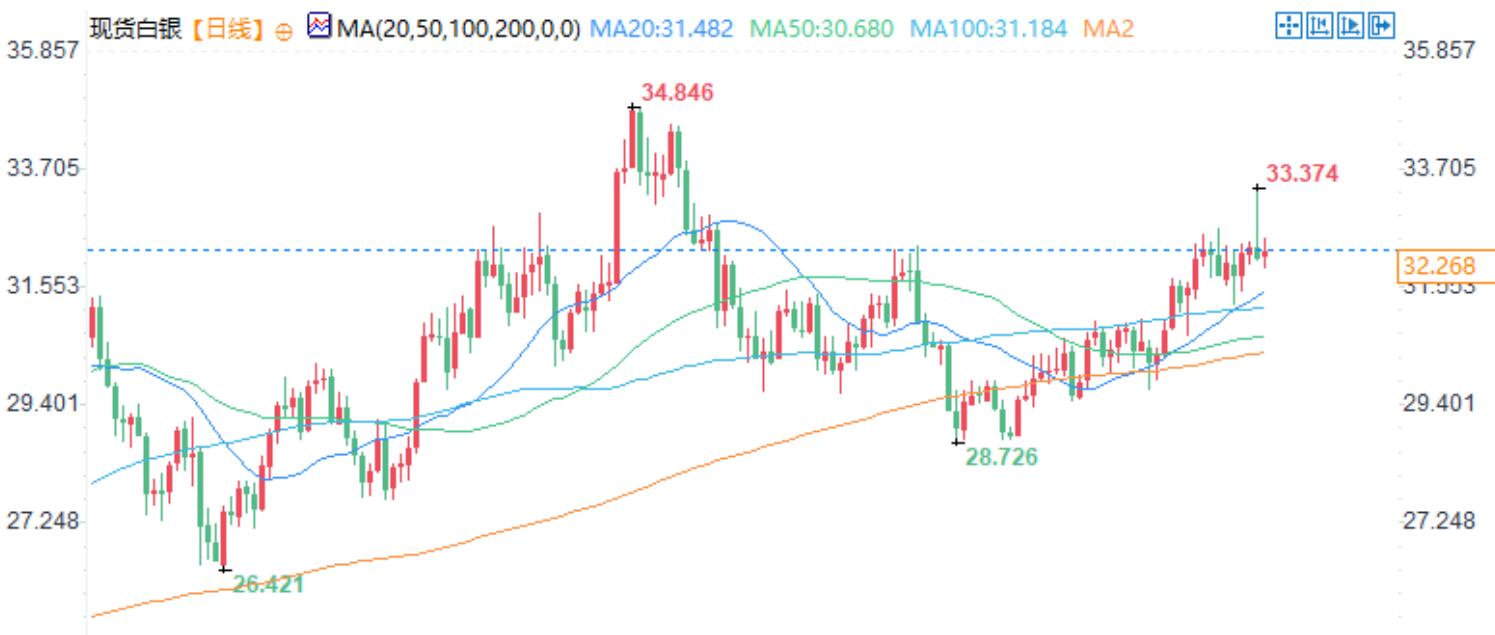Analysis of Silver Price Trends: Can It Stand Above $35?
On Monday (February 17th) during the European trading session, silver prices rose as traders closely monitored key technical levels. The market is facing resistance at the Fibonacci level of $32.53, with support at $31.81. Breaking through resistance levels may lead to testing last week's high of $33.39, while failing to hold support levels may push the price down to the main bottom of $31.25.
Silver is still within the correction range of $31.81-32.53, which currently determines its short-term trend.
Silver follows the rise of gold, but faces volatility risks
Silver has been benefiting from the surge of gold, with spot prices recently hitting $33.39, the highest level since the end of October last year. Supported by strong demand in the gold and industrial markets, gold prices have risen 14% so far in 2025 and 21% in 2024.
Although some analysts believe that silver prices may challenge the 10-year high around $35, there are also analysts who are cautious. Silver has always lagged behind gold and often fluctuates more.. Silver's failure to keep up with gold's record breaking rise in 2024 has raised doubts among traders about the sustainability of its recent gains.
US tariffs and market price differentials drive silver demand
A key factor contributing to the recent strength of silver is concerns about US trade policy. The threat of high import tariffs, originally scheduled to be implemented in the near future but later postponed to March, has driven up the price of silver futures on the New York Mercantile Exchange (Comex) in the United States. The latest March contract rose 3.3% to $33.79.
At the same time, the widening price difference between Chicago Mercantile Exchange silver futures and London spot prices has prompted a large influx of funds into warehouses approved by the New York Mercantile Exchange. Since November last year, silver inventory on the Chicago Mercantile Exchange has surged 22% to 375.8 million ounces, while inventory in London vaults fell 8.6% in January, marking the largest monthly decline on record. This shift has sparked speculation that the silver supply chain is tightening, increasing bullish sentiment.
At the same time, the premium between Chicago Mercantile Exchange silver futures and London spot prices widened, prompting a large amount of funds to flow into warehouses approved by the New York Mercantile Exchange. Since November last year, the silver inventory of the Chicago Mercantile Exchange has risen by 22% to 375.8 million ounces, while the inventory of the London Treasury decreased by 8.6% in January, the largest single month decline on record. This change has sparked speculation in the market about a tightening of the silver supply chain, further fueling bullish sentiment.
High volatility of silver reminds traders to operate cautiously
Despite recent gains, the volatility of silver remains a concern. From a historical perspective, when gold shows a decisive trend, the price fluctuation of silver is usually 2.0-2.5 times that of gold. In 2024, gold reached a historic high of 40, while silver failed to reach a new peak, which left traders feeling frustrated.
From a technical perspective, the price range of silver from $22 to $35 was unusually broad last year, compared to the previous year's price range of $19 to $27. This indicates that silver may experience more severe fluctuations, especially in the context of increasing global economic uncertainty. Potential trade frictions may suppress industrial demand, which accounts for about half of the total silver demand.
Market forecast: Silver faces key technical challenges

The short-term outlook for silver depends on the range of $31.81-32.53. Breaking through the resistance level of $32.53 will demonstrate market strength and open the door for prices to move towards $33.39 or even $35. However, if the support level of $31.81 cannot be maintained, market momentum may shift downwards, with the next major observation level being $31.25.
Given the sustained high volatility and uncertainty in the global economy, traders should be prepared to deal with significant price fluctuations on future trading days.
Tips:This page came from Internet, which is not standing for FXCUE opinions of this website.
Statement:Contact us if the content violates the law or your rights
